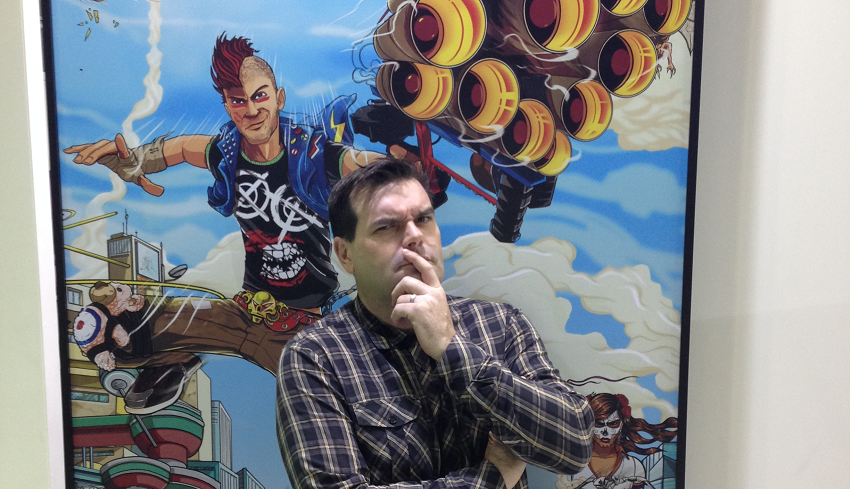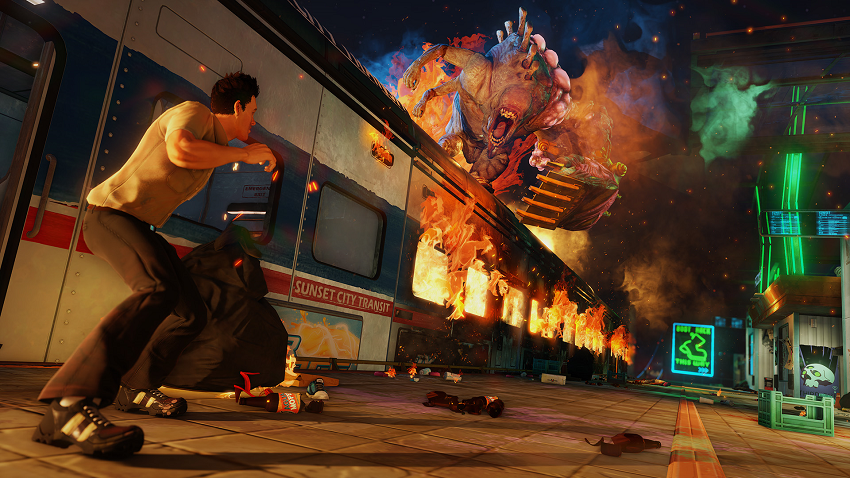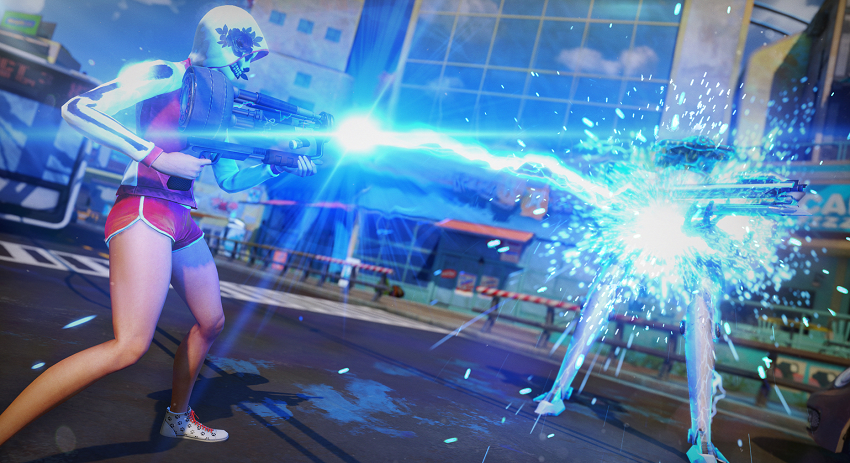Interview – Marcus Smith, Creative Director, Sunset Overdrive
 At the recent EB Expo, Save Game caught up with Marcus Smith, Creative Director at Insomniac Games, and talked all things Sunset Overdrive. From the tone of the game, to challenges faced, to exactly what Overcharge Delirium XT would taste like – a whole bunch of topics were discussed. The full interview is below.
At the recent EB Expo, Save Game caught up with Marcus Smith, Creative Director at Insomniac Games, and talked all things Sunset Overdrive. From the tone of the game, to challenges faced, to exactly what Overcharge Delirium XT would taste like – a whole bunch of topics were discussed. The full interview is below.
Sunset Overdrive has a much brighter tone than other Insomniac Games of the recent past, like Resistance and Fuse. Was this a conscious decision on behalf of the company to move away from the darker, grittier style of those games? Was it refreshing to work on something with a lot of colour and humour again?
Marcus Smith: Well it wasn’t a company decision it was Drew Murray, the game director, and I, a long time ago when we were still working on Resistance 3 we had a lunch and just started talking about what was the game you would make if people gave you money to make a game, which seemed ludicrous at the time, and we were both fans of Insomniac before we came there and we loved that Insomniac games did not take themselves too seriously, that the tone was always lighter and kind of funny but also has these subversive tones, taking little cracks at Fox News and things like that every once and a while. So it seemed a natural fit to us that we would want to do games like that because that’s why we came here and I think a lot of other people at the studio feel the same way. They came because they loved working on Ratchet, and while Resistance and Fuse were a little bit of a departure, it also taught us a lot about making those type of games, the controls have to be super tight on first person shooters and the animation systems for Fuse that made everybody look good when they were moving. Lessons were learned and to me it’s kind of a fusion. It is going back to its roots in terms of tone but it is definitely a fusion of all the games we have made up until this point.
The character movements of Sunset Overdrive seem like a mix of old school Tony Hawk games and Prince of Persia multiplied by a factor of ten and then you throw in some of the craziest weapons I have ever seen in a game. What was the inspiration behind combining those elements?
Marcus Smith: It was one of those things that evolved. We knew that we wanted to do something that was stylised early on just because we wanted to be different, we didn’t want to be yet another zombie apocalypse open world game and as we were going one of the first demo’s we did was a petrol station and you had to defend it, kind of like the Chaos Squad mode. You could get high to snipe and things like that and we had all these ladders and we started playing it and we were like “You know what, ladders suck, ladders are terrible.” At no point in a video game is anybody going to go “Oh thank god a ladder.” So that was the first step at making this more traversal based combination of combat and movement. We started replacing ladders with little exercise trampolines so the player could bounce over things and that ended up being so much fun that we started doing more and more of that. One of our designers was really pushing the idea because he was a fan of Jet Grind, Jet Set Radio and Tony Hawk and a lot of those games. So it just started to kind of make sense, we knew we wanted a fast paced game and nothing is faster paced than being able to bounce and move and grind and fight at the same time. And the its an insomniac game so the weapons have to be crazy otherwise there would be outrage and mutiny.
The combat in Sunset Overdrive places a high value on style and momentum. Can you explain how the games amps, style meter and combo counter work, and why they shouldn’t scare off fans of the more traditional shooters?
Marcus Smith: As I said… (scream from The Evil Within Maze) was that a drop bear? I’m outta here.
I think they are all over that way.
Marcus Smith: Ok thank god. So ah … (more screams) they’re getting closer … (more screams) There is something terrible going on over there. Ah what was the question? Oh right the style metre and amps.
So they way it works, like Tony Hawk, one of the important things to me about Tony Hawk was if you were a noob, a new player, you could pick up the controller and do something cool without much effort, without much skill, but then as you developed your combos you got really, really good. So it was an inviting way to play the game, where I did not have to learn how to actually do a kick flip to do a kick flip, unlike other skating games, and so that was important to us that it’s a game that you can have fun even if you’re not an advanced player and you don’t understand the combo system
The way the combo system works is basically everything you do from chaining a bounce to a grind or wall run, any of those things will start building up a combo metre and that will help build your style meter faster. The style meter has multiple tiers and each of the tiers open up amps, which are modifiers that you can craft yourself in the game and decide what you apply. There will be an amp for melee, an amp that works on yourself, there will be an amp for everyone of your weapons, so lets say one of the amps could be it has a percentage chance of turning one of the enemies you shoot into an ally. You put that on the turret copter, which is a remote control helicopter with a gun tied to it, and if you put the amp on that weapon once you reach style meter tier two, all of a sudden that gun is going to be recruiting enemies to your side, you may not even be paying attention and all of a sudden you have enemies fighting for you, and so you start combining these things into very interesting combinations. Likewise you can cater the amps that you have to your play style, like I built out a really melee specific set of amps and it was awesome. People would come up to me and there would be a shield that would pop up if they tried to attack me, I had a chance of exploding them when I would melee and it was beautiful and super fun and that’s the kind of things that amps do. Its just that momentum, as you start doing awesome things, you’re killing guys, you’re traversing, you’re killing guys while traversing, and you’re going to be unlocking these other abilities to the point where if you fill out your style meter its bat-shit crazy, everything is going nuts.
One of the things I am curious about. I am a big fan of campaign co-op. With the chaos squad mode it is not part of the campaign but you do get things to take into the campaign and things you can bring from the campaign. Why, in a game as crazy as this with people bouncing around and blowing stuff up, why go with that mode of co-op rather than putting in a campaign co-op and is there a chance of it appearing later on?
Marcus Smith: Well in terms of not having co-op in the main campaign the main thing was we wanted to have a lot of very specialised moments in the game. We don’t want it to be a campaign where you do the same thing over and over again. We wanted to cater to very specific single player-esque moments that don’t work all that well for two players. You always have to consider what happens if the second player does ‘blah’ and all of a sudden those mechanics have to go away. So we just said upfront people are going to have a fun co-op experience in Chaos Squad, people can play together but in the story mode it is very specific to a single character. I’ll say there is probably very little chance that it is coming for this game but definitely something we are thinking about in the future… if there’s a future.
Insomniac spent much of its existence making games for Sony’s Playstation consoles. The you went multi-platform with your last release Fuse. What made you decide to make Sunset Overdrive exclusively for Xbox One?
Marcus Smith: It’s a business decision. We are an independent studio and there is not many of us left out there and ultimately Ted Price is the owner, he is very pragmatic, he has had a company making games for 20 years when almost everyone else was shuttered or bought up and it’s a pragmatic decision, we want to be able to have a wide portfolio and to work with as many different publishing partners as possible because having all your eggs in one basket isn’t necessarily the best business decision. We still work with Sony, we have a Ratchet and Clank PS4 title that’s going to be coming out, but for this game it was a partnership that kind of developed and made a lot of sense. They have been super supportive. From day one they wanted it to be a stylised game, they believed in our vision and helped us fulfil it so I have got nothing but good things to say.
How did you pitch it to them though?
Marcus Smith: When we had to do the pitch, Drew and I really really like this game, we flew up to Redmond to pitch it. We started off with Kick Out The Jams by MC5, so the beginning is “Kick out the jams mother fucker” over the PA system of this executive boardroom with 6 levels of hierarchy, and then we just ran through the game and it culminated in Drew talking about the gameplay and he was talking about night defence and the feeling of waiting for the sun to come up, and it’s chaos and people are coming, and he got up on his chair and was like “And we’re fighting them off”, and I think everyone in the boardroom was just sitting there like “What the hell is going on?” Now I have no idea if they believed in the project at that point but they believed in our passion.
This is your first open world game and on one of the next-gen consoles. What were some of the challenges you faced that you were not expecting and how did you overcome them?
Marcus Smith: I think the big one was just as an open world game streaming is the big question. How do you actually get the data into memory so it can be running fast enough to render on screen. Luckily in previous games we had already developed streaming technology for our LOD systems to make sure it was the highest level of detail around you, but in an open world you have to be predictive about where the player is going to be at any particular moment. So we had to develop a streaming system that worked with an open world, and that took us a bit in pre-production, but for this game the most difficult thing was that, normally designers would design a level and then artists would come in to beautify it and make it pretty, they turn all of those ideas into something that looks real, and in this case all of the environment is also a gameplay element, you can grind on that rail, you can bounce on that awning, you can do all those things. So design and environment art had to work together like we have never done before and a lot of communication back and forth. You have to check your ego at the door. An artist can’t come in and say “Oh well you just blew up my beautiful vista” and the designers had to give up elements to make sure that the world looked inviting and have the compositional elements that allow people to understand what the hell is going on. So kudos to those guys for pulling it off but I know trying to figure out the metrics of everything was a real issue.
Now my last question and it is one my Editor insisted on. If you could relate the taste of Overcharge Delirium XT to a real world beverage or combination of beverages, what would it be like?
Marcus Smith: It would have that late night with vodka feel of Redbull, with a Fanta twist and the scantily clad girls and innocuous theme song in the background every time you drink it, and there is probably a fair amount of cocaine involved along with some inner monologuing. Oh and it turns you into a mutant so there is that down side.
Save Game would like to thank Marcus for his time. Sunset Overdrive will be out for Xbox One on October 28 in North America, and October 31 in Europe. For more information, take a look at the game’s official website.





